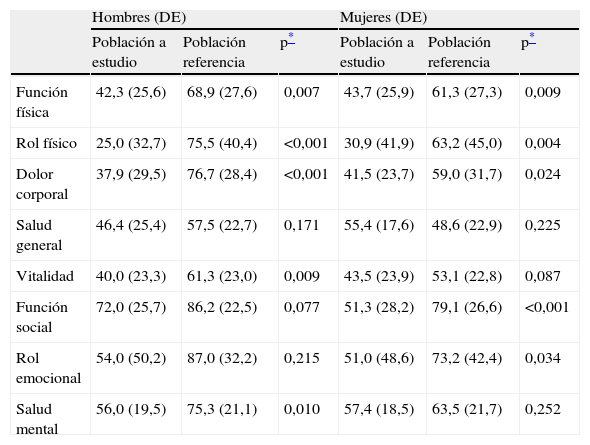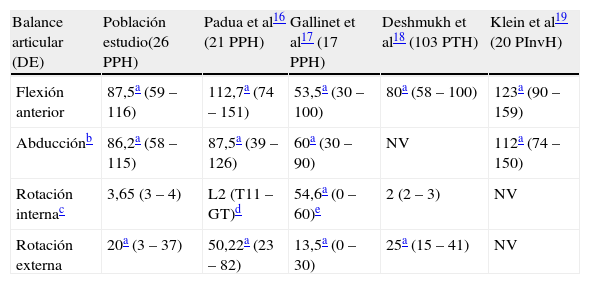La implantación de una prótesis de hombro requiere una correcta indicación y para mejorar la funcionalidad es necesario un adecuado tratamiento rehabilitador. El objetivo del estudio es analizar la funcionalidad y la calidad de vida relacionada con la salud (CVRS) a largo plazo de pacientes con prótesis parcial de hombro (PPH) y compararlas con valores poblacionales de referencia.
Material y métodoEstudio transversal de 52 pacientes intervenidos de PPH por fractura y artrosis de humero proximal entre 1997–2007. Instrumentos de medida: cuestionario Disabilities of the Arm, Shoulder and Hand (DASH), cuestionario de CVRS Short-Form-36 (SF) sus valores poblacionales y escala visual analógica (EVA). Para el análisis se utilizó SPSS versión-15.
ResultadosDe los 52 pacientes intervenidos se valoraron 25 con 26 PPH. La edad media de la intervención quirúrgica fue 65±6,5años y el tiempo medio de evaluación 6,3±3,1 años. El período medio de rehabilitación fue 4,9 meses. Los resultados del cuestionario DASH mostraron de media 57,9. La media del SF-36 fue hombres/mujeres: función-física 42,3/43,7; rol-físico 25,0/30,9; dolor-corporal 37,9/41,5; salud-general 46,4/55,4; vitalidad 40,0/43,5; función-social 72,0/51,3; rol-emocional 54,0/51,0; salud-mental 56,0/57,4. La media del EVA en hombro fue de 2,8cm. El balance articular activo fue de media: flexión-anterior 87°, abducción 86°, retropulsión 49°.
ConclusionesLos pacientes con PPH son pacientes de edad avanzada cuya funcionalidad de miembro superior se ve reducida, pero consigue mejorar el dolor incapacitante que quedaría tras las fracturas proximales de húmero.
La CVRS también se ve afectada respecto a la población de referencia excepto función-social y rol-emocional, en hombres; vitalidad y salud-mental, en mujeres, y salud-general, en ambos.
The shoulder replacement is a surgical treatment that needs a correct indication. In order to avoid a functional impotence, it is necessary to follow a suitable rehabilitation treatment.
The aim of this study is analyze the functionality and the patient's quality of life with shoulder hemiarthroplasty and compare them with population reference values.
Material and methodIn 2008, a crossectional study was performed over 52 patients with shoulder hemiarthroplasty between 1997 and 2007. The measurement instruments used were the DASH questionnaire(Disabilities of the Arm, Shoulder and Hand), the quality of life questionnaire SF-36 (Short Form) and its population values and Visual Analogical Scale (VAS). The statistical analysis was done by the program SPSS version 15.
Results52 patients followed a shoulder hemiarthroplasty where evaluated 25 patients were evaluated with 26 hemiarthroplasties. The mean age of the surgical treatment was 65 ± 6.5 years old. There mean period of rehabilitation was 4.9 months. The results of the DASH questionnaire showed mean score of 57.9. The mean of the SF-36 was: Physical Function 43.2; Physical Role 29.0; Corporal Pain 40.3; General Health 52.5; Vitality 24.4; Social Function 43.3; Emotional Role 52.0; Mental Health 57.0. The mean VAS in shoulder was 2.8cm. The range of movement was: elevation 87°, abduction 86° and retropulsion 49°.
ConclusionsThe patients with shoulder arthroplasty are elderly patients, which functionality decreases from time to time.
The quality of life is also deteriorated according to the reference population but in the general health domain.
Artículo
Comprando el artículo el PDF del mismo podrá ser descargado
Precio 19,34 €
Comprar ahora









